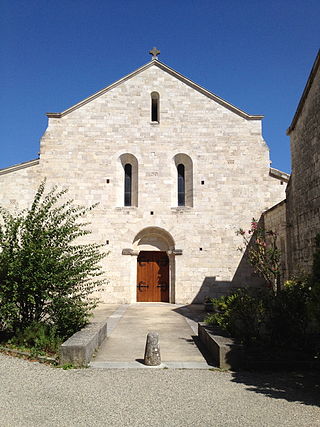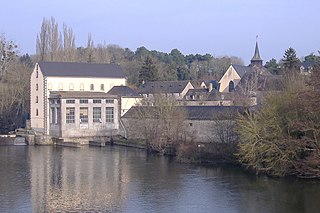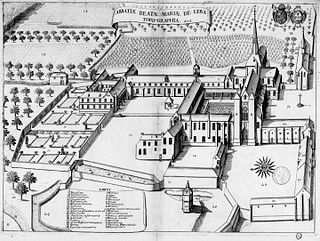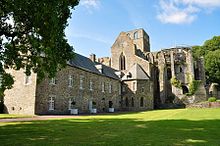
Aiguebelle Abbey is a Trappist monastery situated in the communes of Montjoyer and Réauville in the département of Drôme, on the borders of the Dauphiné and of Provence, France.

Fontgombault Abbey, otherwise the Abbey of Notre-Dame, Fontgombault, is a Benedictine monastery of the Solesmes Congregation located in Fontgombault in the département of Indre, in the province of Berry, France. It was built in the Romanesque architectural style. The monastery, founded in 1091, was dissolved in 1791 and refounded in 1948.

Ouche Abbey or the Abbey of Saint-Evroul is a former Benedictine abbey in Normandy, located in the present commune of Saint-Évroult-Notre-Dame-du-Bois, Orne, Normandy. It has been classified as a Monument historique since 1967 and is designated "classé".

Les Préaux is a commune in the Eure department and Normandy region of France.

Orbais-l'Abbaye is a commune in the Marne department in north-eastern France. The abbey at Orbais was founded at the end of the 7th century by Saint Réol, and the remains are situated in the centre of the town.
Gerald of Sales was a French monastic reformer from Salles, Lot-et-Garonne near Bergerac, Dordogne in the south-west of France. His feast day is on April 20.

Grestain Abbey was an 11th-Century Benedictine monastery near the town of Fatouville-Grestain, which is located in the modern-day Eure département of Upper Normandy, France. The abbey was in the Catholic Diocese of Lisieux. Closely associated with the family of William, Duke of Normandy, the abbey was instrumental in the Normans taking control over the Church in England in the centuries following the Norman Conquest of England, establishing new churches and priories in England, and Abbots of Grestain ordained many English priests. Many churches mentioned in the Domesday Book of 1086 cite Grestain as the founding establishment.

Valmont Abbey is a Benedictine abbey in Valmont, Seine-Maritime, France. Its chapel and surviving ruins of other parts of the abbey were classed as historical monuments in 1951 and the facades and roofs of all the abbey buildings were made historic monuments in 1965.

Port-du-Salut Abbey, also the Abbey of Notre-Dame du Port du Salut is a Trappist monastery located in Entrammes, Mayenne, France. The main monastery building dates from around the 13th century.

The Mont-Saint-Michel Abbey is an abbey located within the city and island of Mont-Saint-Michel in Normandy, in the department of Manche.

Maredret Abbey, also known as l’Abbaye des saints Jean et Scolastique, is a monastery of Benedictine nuns located on the edge of Maredret, a very small village in the hilly countryside to the south of Charleroi and Namur, Wallonia, Belgium. The abbey was inaugurated with the installation of seven nuns in 1893, and the abbey church was constructed between 1898 and 1907.

Lyre Abbey was a monastery in Normandy, founded in 1046 at what is now the village of La Vieille-Lyre. From the mid-12th century it was a Benedictine house. It was abolished at the French Revolution and the abbey buildings mostly destroyed.

Bernay Abbey was a Benedictine abbey in Bernay, Eure, France. The designers of its abbey church were ahead of their time, making it one of the first examples of Romanesque architecture in Normandy. It shows the early evolution of that style, its decorative elements and its building techniques.

The Abbey of the Holy Trinity is an 11th century Romanesque Benedictine Abbey church located in Lessay, Manche, France, then in Normandy. The abbey is one of the most important Norman Romanesque churches, and, along with Durham Cathedral, one of the first examples use of the rib vault to cover the choir in about 1098. This element became a key feature of Gothic architecture. The abbey was nearly destroyed in 1357. It was destroyed in 1944 and subsequently rebuilt.

Fontenelles Abbey or Les Fontenelles Abbey was an Augustinian monastery in the former commune of Saint-André-d'Ornay, in the Vendée, France.

Dalon Abbey is a former Cistercian monastery in Sainte-Trie, Dordogne, southwestern France. It is listed as a Historic Monument.

Montivilliers Abbey is a former Benedictine nunnery, founded between 682 and 684 by Saint Philibert in the town of Montivilliers in Normandy, in the present department of Seine-Maritime, France. It was suppressed during the French Revolution, but many buildings, including the church, have survived.

Saint-Maur Abbey, originally called the Abbaye des Fossés, is a former abbey now subsumed in the Saint-Maur-des-Fossés suburb of Paris, France. The remains and the domain of the abbey have been transformed into a pleasure park named Parc de l'abbaye. The former abbey building has been replaced by a square at the corner of Avenue de Condé and Rue de l'Abbaye. Some ruins remain, such as the Rabelais tower, the 19th century Bourières villa and the old fortifications. The remains of the abbey have been classified as historical monuments since 13 June 1988.
















